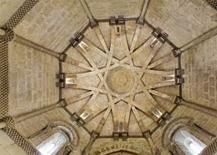
Locality: TORRES DEL RIO (31229)
Zone: The Central Zone
Style: Romanesque
Centuries of construction: XII
Just before leaving Navarre, the Pilgrim’s Way to Santiago offers us this beautiful, secluded example of 12th-century Romanesque, which was a funeral chapel and beacon along the route.
According to some historians, the church of the Holy Sepulchre in Torres del Río could be the work of the Knights Templar. This possibility has not been confirmed but it does add to the mystery of this site, which was built in the likeness of the Holy Sepulchre in Jerusalem, yet adapting Islamic knowledge to the building techniques of the Christians.
Description
With its octagonal shape, the Church of the Holy Sepulchre is a rare example of medieval art, in contrast to the horizontal and heavy appearance of Romanesque constructions. In this church everything leads to verticality. Inside, the stunning vaulted roof of intertwined ribs will remind you of Hispanic-Muslim art.
The Church of the Holy Sepulchre stands in the centre of Torres del Río, a small pilgrim’s route town in the Central Zone of Navarre that lies between the top of a hill and a deep hollow, close to the lands of La Rioja.
Here, visitors will find a Romanesque treasure, built around 1170 as a replica of the basilica in Jerusalem, in which the circular shape has been replaced by a polygon.
Associated since its origin with the Pilgrims’ Way to Santiago, like the church of Santa María de Eunate it provided a beacon for pilgrims, who guided themselves thanks to the lantern that shone from the top of the building. In addition, the land around the church served as a pilgrims’ cemetery.
In an octagonal layout with a perfectly balanced finish, this is a sober and harmonious building in which three different sections can be clearly identified: the first is blind, the second is illuminated by two small windows, and the third and upper section opens up in two semicircular windows that illuminate the splendid inner dome. On either side, the building has retained its apse and a cylindrical tower, and on the octagonal turret there is a similarly shaped lantern which replicates, in miniature, the actual body of the church.
Inside
To access the building you should approach it from the door on the south side whose tympanum features a patriarchal cross, the insignia of the Sacred Military Order of the Holy Sepulchre in Jerusalem.
Inside the church, your gaze is drawn upwards to the magnificent dome of thick ribs of Arabic influence that crowns the interior and outlines an eight-pointed star illuminated by the tenuous light that filters in through the latticework. The ribbing recalls similar examples in Islamic mosques, which has led to speculation that the monument was possibly built by Mudejar artisans who would have reached Torres del Río from the banks of the river Guadalquivir.
In the apse, watching over the church, is a Christ from the 13th century, also known as the Holy Christ of the Knights of the Sepulchre. Here, too, you will see a Moorish influence in the delicate columns and capitals that reproduce monsters and centaurs.







